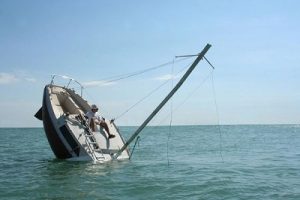How To Keep Your Boat From Sinking
 Tens of thousands of boats of all types and sizes sink every year, most of them at their dock. The exact number is not known because there is no agency that keeps statistics. But just ask any marine insurance company and they will tell you that the number is far too high. In fact, sinking is the number one cause of major marine losses, and one of the primary reasons why marine insurance costs so much.
Tens of thousands of boats of all types and sizes sink every year, most of them at their dock. The exact number is not known because there is no agency that keeps statistics. But just ask any marine insurance company and they will tell you that the number is far too high. In fact, sinking is the number one cause of major marine losses, and one of the primary reasons why marine insurance costs so much.
Why do boats sink? It’s true that a large number of boats sink because people neglect them and allow them to sink. But the primary reason boats sink is due to poor design and the use of inferior materials. A global survey of the boat building industry has shown that 64% of all builders do not have a trained designer on staff. That means that a lot of boats are designed by people with less than professional expertise. Another factor is that style has taken precedence over function and practicality, often resulting in boats that are doomed to sink themselves. The sort of bad design that results in boats sinking breaks down into two categories, basic hull design and internal systems.
Hull Design
Hull design problems usually involve boats under 40 feet and more often boats under 30 feet. Obviously, the smaller the boat, the more prone to sinking. It is simply because it can sink so much faster. The most common reason power boats sink is due to improperly designed cockpits. In order to keep people from falling overboard, it is necessary that the gunwale be of a certain height. If it does not come up above the knees of the average sized person, then a person is more likely to fall overboard. For sailboats, the most common cause is improper head installation, sink drains, inadequate bilge pumps and battery systems that don’t supply enough power to run the pumps.
In smaller boats such as runabouts and sport fishermen this creates a design problem because the cockpit deck then has to be placed very close to the water line to achieve this height. On the other hand, builders like to make the cockpits “self-bailing” to allow rain water or waves over the stern to drain off. Therefore, they add drain scuppers in the transom. Unfortunately, water can travel in both directions and the water that runs out can also run in, even with flappers in place. And if the cockpit deck is very close to the water line – say a few inches – then any change in trim of the boat can result in the cockpit deck flooding.
Also, consider whether the cockpit deck is really water tight, despite those plastic hatch covers with the little gaskets on the underside (this refers primarily to rectangular hatches and not the round type with screw-on covers which are much better at sealing because they are small). I have conducted my own experiments on whether plastic hatches are watertight. The results proved overwhelmingly that not only are they not watertight, but often can allow large amounts of water to leak through the supposedly gasket-sealed cover. This happens simply because the hatch covers and frames are thin, flimsy plastic that can easily distort, resulting in the gasket not sealing at all.
Dirt and debris falls down into the gap and gets under the gasket when the hatch is opened and replaced without first being cleaned. When this happens, that gasket is only sealing to a layer of dirt which then lets water run through. To make matters worse, those hatch covers are likely to be located close to the stern for access to bilge pumps, rudders and the like.
To check if your cockpit scuppers are safe, first measure the height above the normal water line with tanks full. Subtract 2″ if they’re near empty. If the height above water is less than 4″ you’ve got a problem. Get three 150 lb. or more persons to stand in one aft corner. Does the cockpit begin to flood with water? If so, your boat is in danger of sinking and you should consider sealing up the scuppers and improving the bilge pump capacity if necessary.
Solving the Leaky Hatch Problem
Leaking plastic hatch problems can be fairly easily be solved by simply replacing it with a piece of Lexan (not plexiglas) plastic, bedded and screwed to the deck in place of the plastic hatch. Yes, it will make access to the pump a bit more difficult. With an electric screw driver, it can be opened up in less than a minute, by hand a little longer. Use 3/8″ thick material for large openings and bevel the edges sharply so you don’t trip on it, and make the seal with silicone – one of the few good uses of this material on a boat. Don’t use 5200 or polysulphide as you won’t be able to get the cover off. The screw heads should be counter sunk; the screws need to be the stubby, coarse thread type so that they’ll have good holding power.
If you give them the finished dimensions, most plastics sellers (the specialty shops) or boat yard can machine the plastic for you. The advantage here is not only will you end up with a water-tight deck or motor well, but you’ll also be able to see into the bilge without opening a hatch. It may be less pretty, but what’s uglier than a sunk boat?
Open Transoms
or boats with no transoms have been appearing on the market with more frequency lately, and many of these are just accidents waiting to happen. A boat without a transom cannot reasonably be called seaworthy unless the internal compartments of the hull are made absolutely watertight. This is almost never the case because the builders never put absolutely watertight hatches in the decks.
They make a mistake by ignoring the probability that at some point in time the vessel will encounter circumstances where waves are crashing over the nonexistent transom, flooding the deck, and thereby endangering the vessel and its passengers. Builders of such boats don’t have the foresight (which they should have) to consider what would happen if such a boat lost power while navigating a dangerous inlet, or breaks down while at sea. Under these circumstances, the lack of a transom becomes very dangerous. Even large sport fishermen with large, open cockpit scuppers or non-sealing transom doors have gotten into trouble under such conditions. If you are the owner of such a boat, you had better think carefully how you use it.
Internal Systems
By far, improper design or use of poor quality materials is the cause of the vast majority of boat sinking. Internal system failures fall into three main categories:
- Reverse siphoning resulting from errors in plumbing design.
- Insufficient bilge pumping or battery capacity.
- Failed through hull fittings and hoses.
Reverse Siphoning
Most prevalent of this type are the installation of a bilge pump or shower sump pump with a thru- hull outlet located close to the water line and without any riser in the discharge hose at all. Again, because of changes in trim, or wave action against the hull, water flows back into the hull through these openings. Despite hundreds of years of design knowledge about this problem, many builders continue to make these same mistakes every year. All discharge outlets close to the water line must have a riser in the discharge hose. 18″ is the recommended height, but in no case should be less than 12″. If your boat has less than this, it is a fairly simple matter to increase the hose length and extend the riser loop a little higher. All shower sumps and bilge pump discharge outlets should be checked for adequate riser height.
Plastic Fittings
It is hard to imagine how a builder of a $100,000 boat can justify the use of twenty dollars worth of plastic through hull fittings, but they usually do. Every year I catch 30-40 boats with broken plastic fittings that are in danger of sinking them. The first generation of these cheap fittings was totally vulnerable to degradation by ultraviolet light (sunlight). Once this became widely known, a second generation of plastic fittings appeared that would last considerably longer, the first generation often failing within just a couple years. Unfortunately, these don’t last long enough. A third generation so far seems to be fairly resistant. Unfortunately, the manufacturer don’t put their name on the fittings (I wouldn’t either if I was selling these things)
In any case, all three grades are in existence and continue to be used. Since these little devils are usually located near the water line, they need to be checked annually when your boat is hauled. Typically, they crack and break off behind the outer flange, so don’t trust just looking at them. To test for strength, insert a screwdriver blade in the hole and, with moderate pressure, pry in several directions. If it breaks off then you know what you have to do. And if one is bad, you may as well figure that all of them will break soon and replace them all.
Hoses
Also watch out for the use of ribbed, thin-wall plastic hose. This material is subject to breakage, particularly when a there is an unsupported length attached to the thru-hull nipple that can bounce around when the boat is underway. The material usually fatigues at the point where it mates to the nipple. The way to test is to pull and twist the hose to see if it cracks or breaks.
Insufficient Bilge Pump Capacity
Many power boats 35′ and under have both too few bilge pumps and inadequate battery power to run them. And for some strange reason, sail boat builders and owners tend to think that only one bilge pump is necessary, no matter how large the yacht is. In fact, the vast majority of 40′ sailboats have only one bilge pump. If you think that’s enough, consider the next point.
Bilge Pump Failure
When bilge pumps fail, most people blame the pump. On the contrary, analysis of hundreds of insurance claims shows that when boats sink, the pump usually failed because of a faulty system before the boat sank. Here’s why:
- Due to dirty bilges, float switch sticks in up or ON position, burns up pump or wears down battery.
- Bilge pump switch is not adequately secured, comes loose and lays on it’s side, causing pump to run continuously, depleting batteries or burning up the pump.
- Debris in bilge prevented float switch from operating. Even oil sludge can do this.
- Wire splices to pump and float switch too low in bilge, or get wet from other water sources such as leaking deck hatches, causing corrosion to the wire connections and resultant failure of the pump. Bear in mind that corroded connections can cause high resistance in the wire that can cause the pump to fail.
Make sure that you have adequate battery power and pumping capacity. For every two pumps, there should be one back up because pumps are notoriously unreliable. That’s why in no way could one pump ever be considered acceptable. More and more builders are recognizing that the primary pump (the one at the deepest point of the bilge) needs to have a backup in the even of failure. Indeed, that is just common sense.
Be sure that wire splices are as high up as possible and that they don’t get wet from other sources. Remember that bilge water bounces around while underway. Coating connections with silicone sealer won’t help. If the area routinely gets wet, install a gasketed plastic junction box. Good ones are available even at Home Depot!
Make sure that the pump discharges have adequate risers. But remember, especially sail boat owners, that too much riser greatly affects the pump’s capacity. A pump located three feet below the waterline, with a 24″ riser (sailboats need this much), for a combined rise of 5 feet, will have its pumping ability reduced by more than 50%. For that reason, sailing yachts need higher capacity pumps. The average Rule 1500 usually just won’t do. Go to a 3500. And remember that pushing water uphill takes more battery power too!
Keep bilges clean, especially free of things like rags, paper, string or crumbling foam insulation. This stuff is deadly around float switches. Make sure the wires aren’t tangling up in the switch.
For power boats, remember that bilge water rushes forward and back while underway. This rush of water can damage float switches. For the stern pump, place the switch with the float facing aft so that the rushing water won’t catch the flapper and tear it off. Use the covered type switch in the center bilge at forward areas.
Battery Power
If you’ve got a 30 footer or larger and are running only a pair of 60 A.H. car batteries, you don’t have enough power for your pumps. This is mainly a problem for gas powered boats since diesel power is always accompanied by large batteries.
I rate batteries by taking their total ampere hour (A.H.) capacity when new and dividing that in half. Batteries age quickly and this is really about all you can expect. As near as I can tell, amperage ratings of pumps seems to be for pumping water sideways, not for pumping against three feet of static head pressure. I’ve measured 6 amp pumps pulling 12 amps under load.
So how long can you expect a pump to run under load on an aging 60 A.H. battery? At minimum you should be running a pair of 90 A.H. true marine batteries in parallel. Pumps should be set up to run off the ALL batteries position on your master switch setting, never just one. For that reason, pumps should never be wired to a battery direct as it will only have the benefit of one battery power.
Remember that all aspects of your system must be maintained for it to work properly. Don’t ignore it for two years and expect it to keep functioning. Your pumping system should be thoroughly checked out annually.
Improper Wiring
Far too many boats are wired so that shutting off the main power, either the main breaker, or the battery switches, shuts off the bilge pumps. It is truly amazing how many builders of expensive yachts make this amateur mistake. That means that if you shut off the power when you leave the boat (even though you’re left pump switches on) you inadvertently turned off your pumps. Testing for this is simple: just shut off the main DC breaker and turn the battery switches to OFF, then lift the float switch and see if the pump works. If not then it is wired wrong.
Outboard Boats
Outboard boats owners should be especially alert to the following dangers:
- Motor wells are intended to keep water out of the hull. If the well is full of holes, it won’t achieve that purpose. Watch out for inspection ports located at the bottom of the well that will leak and possibly sink the boat. Make sure that the gasket is in good condition and the mating surface is clean. Ideally, these things should not be there. Replace it with Lexan as described above.
- Openings for control cables and steering within the motor well should be located above the level of the transom cut down for motor mounting. If the openings are below this, they must be sealed and relocated higher up. A motor well should be absolutely water tight.
- If cockpit scuppers threaten to sink the boat, close them up. Better to rely on the bilge pumps than to run this risk.







